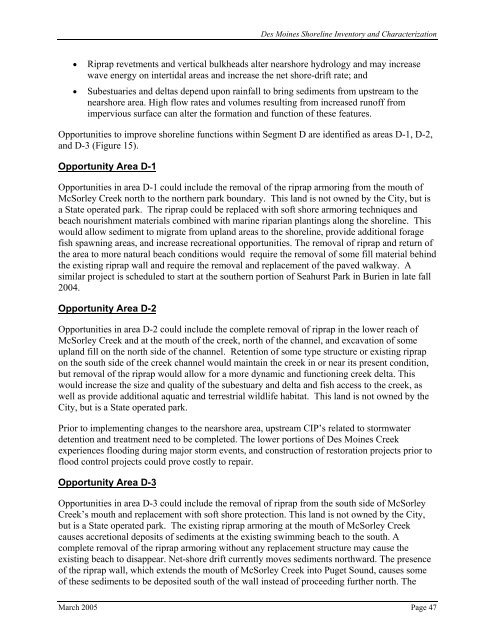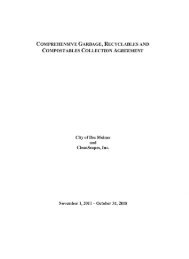CITY OF DES MOINES SHORELINE MASTER PROGRAM
CITY OF DES MOINES SHORELINE MASTER PROGRAM
CITY OF DES MOINES SHORELINE MASTER PROGRAM
You also want an ePaper? Increase the reach of your titles
YUMPU automatically turns print PDFs into web optimized ePapers that Google loves.
Des Moines Shoreline Inventory and Characterization<br />
• Riprap revetments and vertical bulkheads alter nearshore hydrology and may increase<br />
wave energy on intertidal areas and increase the net shore-drift rate; and<br />
• Subestuaries and deltas depend upon rainfall to bring sediments from upstream to the<br />
nearshore area. High flow rates and volumes resulting from increased runoff from<br />
impervious surface can alter the formation and function of these features.<br />
Opportunities to improve shoreline functions within Segment D are identified as areas D-1, D-2,<br />
and D-3 (Figure 15).<br />
Opportunity Area D-1<br />
Opportunities in area D-1 could include the removal of the riprap armoring from the mouth of<br />
McSorley Creek north to the northern park boundary. This land is not owned by the City, but is<br />
a State operated park. The riprap could be replaced with soft shore armoring techniques and<br />
beach nourishment materials combined with marine riparian plantings along the shoreline. This<br />
would allow sediment to migrate from upland areas to the shoreline, provide additional forage<br />
fish spawning areas, and increase recreational opportunities. The removal of riprap and return of<br />
the area to more natural beach conditions would require the removal of some fill material behind<br />
the existing riprap wall and require the removal and replacement of the paved walkway. A<br />
similar project is scheduled to start at the southern portion of Seahurst Park in Burien in late fall<br />
2004.<br />
Opportunity Area D-2<br />
Opportunities in area D-2 could include the complete removal of riprap in the lower reach of<br />
McSorley Creek and at the mouth of the creek, north of the channel, and excavation of some<br />
upland fill on the north side of the channel. Retention of some type structure or existing riprap<br />
on the south side of the creek channel would maintain the creek in or near its present condition,<br />
but removal of the riprap would allow for a more dynamic and functioning creek delta. This<br />
would increase the size and quality of the subestuary and delta and fish access to the creek, as<br />
well as provide additional aquatic and terrestrial wildlife habitat. This land is not owned by the<br />
City, but is a State operated park.<br />
Prior to implementing changes to the nearshore area, upstream CIP’s related to stormwater<br />
detention and treatment need to be completed. The lower portions of Des Moines Creek<br />
experiences flooding during major storm events, and construction of restoration projects prior to<br />
flood control projects could prove costly to repair.<br />
Opportunity Area D-3<br />
Opportunities in area D-3 could include the removal of riprap from the south side of McSorley<br />
Creek’s mouth and replacement with soft shore protection. This land is not owned by the City,<br />
but is a State operated park. The existing riprap armoring at the mouth of McSorley Creek<br />
causes accretional deposits of sediments at the existing swimming beach to the south. A<br />
complete removal of the riprap armoring without any replacement structure may cause the<br />
existing beach to disappear. Net-shore drift currently moves sediments northward. The presence<br />
of the riprap wall, which extends the mouth of McSorley Creek into Puget Sound, causes some<br />
of these sediments to be deposited south of the wall instead of proceeding further north. The<br />
March 2005 Page 47



